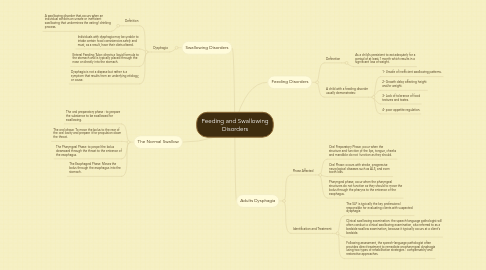
1. Swallowing Disorders
1.1. Dysphagia
1.1.1. Definition
1.1.1.1. A swallowing disorder that occurs when an individual exhibits an unsafe or inefficient swallowing that undermines the eating/ drinking process.
1.1.2. Individuals with dysphagia may be unable to intake certain food consistencies safely and must, as a result, have their diets altered.
1.1.3. Enteral Feeding Tube: directs a liquid formula to the stomach and is typically placed through the nose or directly into the stomach.
1.1.4. Dysphagia is not a disease but rather is a symptom that results from an underlying etiology, or cause.
2. The Normal Swallow
2.1. The oral preparatory phase : to prepare the substance to be swallowed for swallowing.
2.2. The oral phase: To move the bolus to the rear of the oral cavity and prepare it for propulsion down the throat.
2.3. The Pharyngeal Phase: to propel the bolus downward through the throat to the entrance of the esophagus.
2.4. The Esophageal Phase: Moves the bolus through the esophagus into the stomach.
3. Adults Dysphagia
3.1. Phase Affected
3.1.1. Oral Preparatory Phase: occur when the structure and function of the lips, tongue, cheeks and mandible do not function as they should.
3.1.2. Oral Phase: occurs with stroke, progressive neurological diseases such as ALS, and even tooth loss.
3.1.3. Pharyngeal phase: occur when the pharyngeal structures do not function as they should to move the bolus through the pharynx to the entrance of the esophagus.
3.2. Identification and Treatment
3.2.1. The SLP is typically the key professional responsible for evaluating clients with suspected dysphagia
3.2.2. Clinical swallowing examination: the speech-language pathologist will often conduct a clinical swallowing examination, also referred to as a bedside swallow examination, because it typically occurs at a client's bedside.
3.2.3. Following assessment, the speech-language pathologist often provides direct treatment to remediate oropharyngeal dysphagia using two types of rehabilitation strategies : compensatory and restorative approaches.
4. Feeding Disorders
4.1. Definetion
4.1.1. As a child's presistent to eat adequtely for a period of at least 1 month which results in a significant loss of weight.
4.2. A child with a feeding disorder usually demonstrates:
4.2.1. 1- Unsafe of inefficient swallowing patterns.
4.2.2. 2- Growth delay affecting height and/or weight.
4.2.3. 3- Lack of tolerance of food textures and tastes.
4.2.4. 4- poor appetite regulation.
